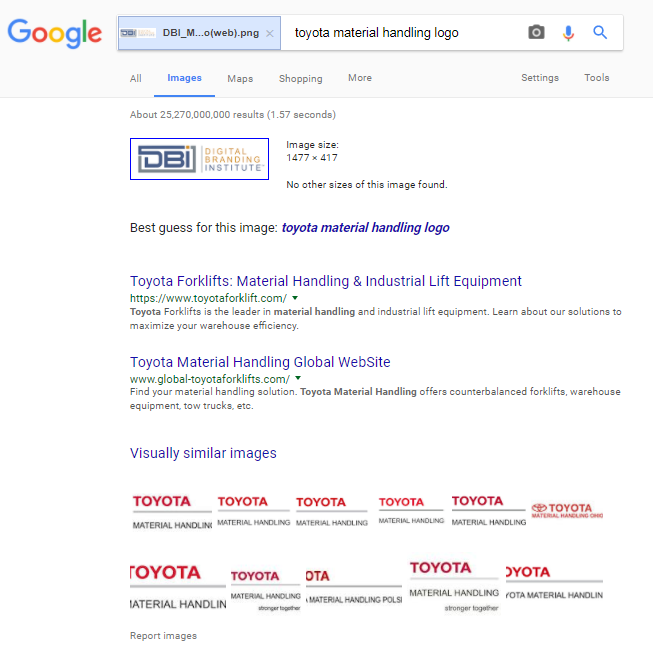Do you know all the information that exists on the Internet? Of course, you don’t. It’s humanly impossible. But do you really want to know everything that’s on the Internet? No, you probably don’t have any interest until the information is about your brand. Right?
Fear of the unknown is all too common for people both in their personal and professional lives. When you are running a business, what’s unknown can lead to disaster.

Which is why you should frequently conduct a digital brand audit. You can save yourself a great deal of time and money if you understand how people are interacting with your brand in the digital space.
Let’s face it, similar to knowing all the information that exists on the Internet, it is humanly impossible to know how your brand is perceived in the digital space.
Although there are several tools you can use to get a glimpse of your brand perception, you must roll up your sleeves, build some sweat equity, use a little elbow grease, or what ever idiom you prefer.
Bottomline, you have to do the work that is needed to stay on top of your brand identity, visibility, and credibility online. So, if you want to ensure that your digital brand is getting you more customers and separating your from your competition, you must conduct a digital brand audit.
Top 4 Reasons to Conduct A Digital Brand Audit
- A brand can recognize where it’s positioned in the digital space. A detailed brand audit helps a brand understand where it ranks in search, its engagement in social media, and where it stands against its competitors.
- A brand can devise more effective strategies that can align its products or services to its designated target audience. Clearly defining your target audience is very important. All the efforts of a digital brand audit will go nowhere if the brand is unsure of who its customers are.
- A brand can better evaluate the strengths and weaknesses of its branding techniques. Conducting a thorough assessment of your digital brand can help you understand why certain marketing strategies work while others don’t.
- A brand can understand how its target audience perceives its brand. When conducting a digital brand audit, a company can formulate plans, whether this is to revamp a product or revise a content strategy, to turn prospects into customers.
SEE ALSO: 6 Things That Can Hurt Your Brand
Questions To Ask Before Your Digital Brand Audit
Before conducting your digital brand audit, you should ask yourself these questions:
- Does your brand position itself better than your competitors? Naturally, your audience expects top-notch products and quality service. They demand that you fulfill all of these expectations and position yourself distinctly amongst competitors–which builds confidence in their decision to work with you or patronize your organization.
- How is your physical brand positioned? You probably heard people say “What happens in Vegas stays in Vegas.” Especially when trying to set ground rules for posting on social media during a trip to Sin City. Unfortunately, this is not true when considering your digital brand. Simply put, what happens offline will end up online. So, you must consider your physical brand when conducting your digital brand audit.
SEE ALSO: 7 Free Google Tools All Digital Branders Should Use
After you’ve answered these questions, you can now begin auditing your digital brand!
Let’s keep going…
Executing A Digital Brand Audit
When you are performing a digital brand audit, your primary goal is to end up with a full summary of how a brand is appearing online and a list of recommended actions that need to be implemented to future-proof a brand.
In order to achieve this, follow the steps outlined below. I have categorized these steps based on the three tenets of digital branding: identity, visibility, and credibility.
First, I’ll start with identity…
Step 1: Future-Proof Your Identity
Your digital identity is an important component of your digital brand. With the Internet being a place where your identity, message, and perception can be altered by a few clicks of a button, it is critical to control as much of your brand as possible. This includes your owned properties such as domain names and social media accounts.
Now, let’s go deeper…
Domains Names
When it comes to future-proofing your brand, I suggest you register the domain names of your business and/or yourself, as well as any products or services your offer. If you don’t have your domain name secured, there is nothing stopping someone from coming along and setting up a company using that same name.
Resource:
Godaddy is known for more than its quirky Super Bowl ads. Besides holding your breath while you watch the video below, you can also use the company to register your domain names.
Social Media Accounts
With so many social media sites popping up all the time, it is important that brands keep a close eye on this and secure profiles before someone else does. This is particularly important for the more well-known brands, as a lot of damage can be done very quickly if a profile gets into the hands of the wrong person. Or, in the case of the Los Angeles Rams, your social media handle can be taken before you know it.

Logo Image Search
Your brand logo is a very important asset to your brand. At this stage of your digital brand audit, you must keep an eye on where the logo is published around the web and check that your logo has not been copied by another brand.
After uploading the Digital Branding Institute logo, Google’s “best guess” for a similar image was the Toyota Material Handling logo. Go figure.

Step 2: Audit Your Identity
Social Media Audit
I’m sure you have a presence on the major social media networks. If not, then you should by now. But don’t stop at having a presence on the major networks as there are plenty of emerging social networks that you should keep an eye on as well.
So, it’s important that you are aware of new channels where you can engage in conversations. As a part of your digital brand audit you should:
- Create social network profiles on emerging networks (maintain a spreadsheet to keep track of multiple accounts).
- Update the descriptions in profile pages and check if links to relevant pages are all there and aren’t broken.
- Change the profile pics, banners, and background images often to keep things fresh.
- Benchmark and re-evaluate the hashtag strategy (identify new hashtags and use them for better visibility).
- Revisit your content mix and posting frequency (focus your efforts to weave more visuals in your posts).
- Evaluate if you are successfully engaging influencers and your audience (make a new list of topics and people to target.)
- Measure the traffic that social networks bring to your website. If people aren’t clicking on the links as much as you would like, try using more emotion in the posts and tag them with industry standard keywords.
SEE ALSO: Measuring Your Digital Brand Impact
Overall, your social media efforts should drive targeted traffic to the website and to build a positive chatter around your brand. As you execute your digital brand audit, look for evidence that your social engagements foster positive chatter and more traffic to your site.
Now it’s time to audit your content…
Content Audit
Content can be used in many different ways. Particularly, it can be used to inform, entertain, or nurture your target audience. Brands are trying to create more and more of it every day.
Should content be a part of your digital brand audit you ask? Of course.
Now let’s dig deeper…
Evergreen Content
The concept of “evergreen content” sounds good but it’s important to revisit your content to ensure that they are still relevant.
For instance, if you write about a current trend, you may have to update that content after a few months. During this part of the digital brand audit, you will get to polish the content, update it with relevant keywords and ensure that the suggestions put forth aren’t outdated.
Blog Posts
And, in the case of blog posts, a content audit will give you a chance to perform a keyword refresh and link to other relevant articles or pages in your website. Search engines love to crawl and index up to date content, so use the content audit as an opportunity to update the content and bring search engine spiders to your pages more often.
Now, let’s geek out…
Step 3: Access Your Brand Visibility
Search Engine Ranking
You could be driving all the traffic in the world to your site, but if you have negative feedback about your brand sitting on page one of the search engine results for your brand term, this can be a deal breaker.
Even if you are not crossing off everything on the SEO checklist every single time, constant monitoring for algorithm updates and monitoring the rankings of individual keywords on a daily basis is highly recommended.
SEE ALSO: The Quick Guide To Getting Your Website To Rank Higher On Google
So, it’s important that you rank high when your target customers are searching for your product or services. So, you should focus both on On-Page and Off-Page SEO as a part of your digital brand audit. Here are the important steps you should take:
On Page SEO Audit
- Run a crawl error report (click the link to run this report via Google Webmaster Tools).
- Identify new keywords using Google Keyword Planner and other third party tools and optimize the pages.
- Check if the existing URL structure is helping your SEO strategy and try changing the permalink structure if the results aren’t satisfactory.
- Find newly added pages or content and look for ways to deep link existing pages.
- Determine if proper alt tags accompany all images and if video SEO has been done for videos if any.
- Fix broken links and check if 301, and 404 redirects are working as they should.
SEE ALSO: How to Improve Brand Signals For Better SEO
Off Page SEO Audit
- Analyze if all the linkbacks are relevant and are of high quality.
- Contact webmasters to take down or remove links from websites that aren’t relevant to your business.
- Figure out if the link building strategy by way of guest blogging is working.
- Stay on top of all Google Algorithm updates. Subscribe to email alerts and RSS feeds of top tier blogs to stay current.
SEE ALSO: 5 SEO Mistakes That Cost You Money
Step 4: Examine Your Brand Credibility
Brand Monitoring
Understanding what is being said about your brand online is essential. A brand can look like everything is going really well, but it is not until you start to dig a little deeper that you may find things that are not very positive.
Negative online customer reviews can not only hurt your brand, they can also impact your search engine rankings, and strongly influence many buyers’ decision-making process. When executing your digital brand audit, knowing the relevant review sites based on your industry is important.
Popular Consumer Review Websites
- Amazon
- Angie’s List
- Better Business Bureau (BBB)
- Bing Places
- Citysearch
- Consumer Reports
- Demand Force
- Dex Knows
- DoneRight.com
- Epinions.com
- Google+ Local / Google Places
- Home Advisor
- Insider Pages
- Judy’s Book
- MerchantCircle
- Trip Advisor
- Yahoo! Local
- Yellow Pages
- Yelp!
Reviews on Social Media Sites
In addition to Google+ Local, LinkedIn and Facebook both offer review and endorsement opportunities.
Industry Specific Review Sites
Many industry specific associations, organizations, and directories offer reviews on their sites. Simply search for a list of industry specific review sites for you to consider during your digital brand audit.
Final Thoughts
You have to do the work that is needed to stay on top of your digital brand identity, visibility, and credibility. So, if you want to ensure that your digital brand is getting you more customers and separating your from your competition, you must conduct a digital brand audit.
What’s more important, a digital brand audit for an individual or an organization? I look forward to your dialog in the comment section…











